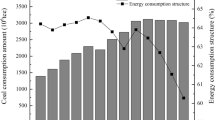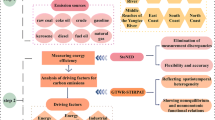Abstract
Population flow can affect regional carbon emissions. Based on the analysis of the dual transmission mechanism of population flow and its effect on carbon emissions, this paper empirically studies the impact of population flow and other related factors on China’s carbon emissions through panel econometric regression and heterogeneity analysis with fixed effect model. The results show that, firstly, in the long or short term, China’s population flow can reduce the growth of carbon emissions. Secondly, the regional population aging and knowledge structure improvement caused by population flow are helpful to reduce carbon emissions, while the regional urbanization improvement caused by population flow is not significantly correlated with the growth of household miniaturization on carbon emissions. Thirdly, from the perspective of heterogeneous geographical divisions, population flow promotes the increase of carbon emissions in the northwest region of the Hu Huanyong Line (Hu Line), while it is opposite in the southeast region of Hu Line. Fourthly, China’s consumption level, per capita GDP, energy intensity, and energy consumption structure have contributed to the growth of carbon emissions, while carbon intensity has a negative effect on carbon emissions. Finally, this paper puts forward relevant suggestions from the perspective of coordinating population policy and energy conservation and emission reduction policy.

Similar content being viewed by others
Data Availability
The datas that support the findings of this study are available from the China Environmental Yearbook, the China Environmental Statistical Yearbook, the China Energy Statistical Yearbook, the China Statistical Yearbook, the China Demographic Yearbook, EPS database and China National Bureau of statistics.
References
Albrecht J, François D, Schoors K (2002) A Shapley decomposition of carbon emissions without residuals. Energy Policy 30:727–736. https://doi.org/10.1016/S0301-4215(01)00131-8
Apergis N, Payne JE (2009) CO2 emissions, energy usage, and output in Central America. Energy Policy 37:3282–3286. https://doi.org/10.1016/j.enpol.2009.03.048
Bălă R-M, Prada E-M (2014) Migration and Private Consumption in Europe: a panel data analysis. Procedia Econ Financ 10:141–149. https://doi.org/10.1016/s2212-5671(14)00287-1
Chen J, Wang LJ, Li YY (2020) Research on the impact of multi-dimensional urbanization on China’s carbon emissions under the background of COP21. J Environ Manag 273:111123. https://doi.org/10.1016/j.jenvman.2020.111123
Cheng LL, Zhang JB, He K (2019) Direct and indirect spillover effects of urbanization on agricultural carbon productivity from a spatial perspective. Chinese J Agric Resources Regional Plan 40:48–56. https://doi.org/10.7621/cjarrp.1005-9121.20191107
Cui PP, Zhao Y, Zhang LJ et al (2020) Spatio-temporal evolution and driving mechanism of per capita indirect carbon emissions based on different demand levels from urban residents’ consumption in China. Acta Ecol Sin 40:301–312. https://doi.org/10.5846/stxb201812242794
Dalton M, O’Neill B, Prskawetz A et al (2008) Population aging and future carbon emissions in the United States. Energy Econ 30:642–675. https://doi.org/10.1016/j.eneco.2006.07.002
Ding XS, Wu ZH, Xia B (2018) The impact of population flow on the scale and structure of compulsory education school-age population in big cities under the background of urbanization. J Educ Sci Hunan Norm Univ 17:66–74. https://doi.org/10.19503/j.cnki.1671-6124.2018.04.009
Du LM (2010) Factors influencing my country’s carbon dioxide emissions: research based on provincial panel data. South China J Econ:20–33. https://doi.org/10.3969/j.issn.1000-6249.2010.11.002
Duan PZ (2008) The influence of population flow in my country on the convergence effect of regional economic growth. Popul Econ 4:1–5 CNKI:SUN:RKJJ.0.2008-04-001
Gao Y, Zhang XL (2016) Metropolitan population structure changes and governance under the background of population flow. Hebei Acad J 36:159–165
Hou YF, Chen ZC (2016) China’s “population mobility economic growth convergence puzzle”—— analysis and test based on Neoclassical endogenous economic growth model. J China Popul Environ 26:11–19. https://doi.org/10.3969/j.issn.1002-2104.2016.09.002
Iraganaboina NC, Eluru N (2021) An examination of factors affecting residential energy consumption using a multiple discrete continuous approach. Energy Build 240:110934. https://doi.org/10.1016/j.enbuild.2021.110934
Kihm A, Trommer S (2014) The new car market for electric vehicles and the potential for fuel substitution. Energy Policy 73:147–157. https://doi.org/10.1016/j.enpol.2014.05.021
Li FY (2015) Aging, urbanization and carbon emissions——based on the research of china’s provincial dynamic panel from 1995 to 2012. Popul Econ:9–18 CNKI:SUN:RKJJ.0.2015-04-002
Li JB (2019) The impact of population aging on labor productivity. Popul. Research 43:20–32 CNKI:SUN:RKYZ.0.2019-06-002
Li FG, Wu LJ (2019) Research on decomposition of driving factors of carbon emission based on LMDI method. Stat Decis 35:101–104. https://doi.org/10.13546/j.cnki.tjyjc.2019.21.023
Li JS, Zhang Z (2017) Research on the impact of Shanghai’s population aging on carbon emissions. J Fudan Univ Sci 56:273–279+289 CNKI:SUN:FDXB.0.2017-03-001
Liu B (2017) Analysis of the impact of population mobility on rural population structure and social development. Yangtze River Ser:121–122
Meng XJ (1993) Education and population growth and mobility. China Popul Environ:61–65
Menz T, Welsch H (2010) Population aging and environmental preferences in OECD countries: the case of air pollution. Ecol Econ 69:2582–2589. https://doi.org/10.1016/j.ecolecon.2010.08.002
Ren XP, Yin ZY (2019) Spatial temporal coupling and driving factors of provincial population agglomeration, public resource allocation and service industry development in China. J China Popul Environ 29:77–86. https://doi.org/10.12062/cpre.20190814
Rong P, Zhang Y, Qin Y, Liu G, Liu R (2020) Spatial differentiation of carbon emissions from residential energy consumption: a case study in Kaifeng. China J Environ Manage 271:110895. https://doi.org/10.1016/j.jenvman.2020.110895
Shao ZZ, Wu KY (2018) Chinese family carrying capacity: construction and evaluation of index system. South China. Popul 33:24–35 CNKI:SUN:LFRK.0.2018-04-003
Shi GF (2020) Research on the mechanism of population flow promoting regional economic growth ——based on panel data of the Yangtze River Delta city cluster. East China Econ Manag 34:10–18. https://doi.org/10.19629/j.cnki.34-1014/f.191125008
Song YY (2017) Research on the impact of human capital. Shanghai Normal University, R&D investment on carbon dioxide emissions -- based on spatial dynamic panel model
Sun W, Huang CC (2020) How does urbanization affect carbon emission efficiency? Evidence from China J Clean Prod 272:122828. https://doi.org/10.1016/j.jclepro.2020.122828
Tang HY, Cui GC, Jiang Q (2017) Population mobility, registered residence segmentation and regional economic structure. J Financ Manag Res 66 10.ssss/j.cn.2017.1.003
Tao AP, Yang S, Li Y (2016) The impact of urbanization quality on the spatial effect of carbon emissions: a case study of 16 cities in Yangtze River Delta. Urban issues 11–18. CNKI:SUN:CSWT.0.2016-12-002
Tian CS, Hao Y, Li WJ, Qu BL (2015a) The impact of China’s population age structure on carbon emissions. 37:2309–2318. CNKI:SUN:ZRZY.0.2015-12-001
Tian PP, Zhu Y, Lin LY, Zhang SB (2015b) The spatial distribution of floating population and the difference of its influencing factors between provinces and provinces -- taking Fujian Province as an example. Popul J 37:56–67. https://doi.org/10.16405/j.cnki.1004-129X.2015.06.006
Tong X, Chen K, Li G (2015) An empirical study on carbon emission and influencing factors in China -- based on grey correlation analysis of China and 30 provinces from 2000 to 2011. J Ind Technol Econ 34:66–78. https://doi.org/10.3969/j.issn.1004-910X.2015.03.009
Tong JP, Chen GD, Yang ZY, Bai C (2018) Research on the threshold effect of residents’ education level on life carbon emissions. Environ Pollut Prev 40:360–364. https://doi.org/10.15985/j.cnki.1001-3865.2018.03.024
Wang LP, Deng H (2021) What causes the intergenerational consumption difference of floating population? J Shandong Univ Financ Econ 33:65–75
Yang F, Lu ZN (2019) Analysis of the impact of population structure on carbon emissions in the process of urbanization: taking Jiangsu Province as an example. Logist Eng Manag 41:130–135 CNKI:SUN:SPCY.0.2019-04-047
Yang CG, Zeng YM (2014) Spatial imbalance, population flow and the regional choice of foreign direct investment——an analysis of China’s inter-provincial spatial panel data from 1995 to 2010. Popul Res 38:25–39 CNKI:SUN:RKYZ.0.2014-06-003
Yin ZL, Song YT, Fan JY, Liu CG (2020) The measurement and decomposition of the spatial imbalance of China’s carbon emission intensity——also on the formation and reduction of regional disparity. Inq into Econ Issues:34–44
Yu Y, Kong QY (2017) An empirical study on the relationship between urbanization, population aging and carbon emissions in Beijing-Tianjin-Hebei. Ecol Econ 33:56–59+80 CNKI:SUN:STJJ.0.2017-08-012
Yuan Y, Sun XT (2020) Exploring the relationship between urbanization, industrial structure, energy consumption, economic growth and CO2 emissions: an empirical study based on the heterogeneity of inter-provincial income levels in China. Clim Chang Res 16:738–747. https://doi.org/10.12006/j.issn.1673-1719.2019.192
Zhou FL (2016) Statistical research on the influence of population movement on family structure. Northwest Popul J 37:43–46. https://doi.org/10.15884/j.cnki.issn.1007-0672.2016.03.008
Zhu Q, Peng XZ, Lu ZM, Yu J (2010) Analytical model and empirical research on the impact of population and consumption on carbon emissions. China Popul Environ 20:98–102. https://doi.org/10.3969/j.issn.1002-2104
Funding
This research was jointly supported by the Open Funds of Regional Innovation Capabilities Monitoring and Analysis Soft Science Research Base of Hubei Province (Grant No. HBQY2021z05) and the Soft Science Research Projects of Hubei Science and Technology Support Plan (Grant No. 2017ADC138).
Author information
Authors and Affiliations
Contributions
Lei Wu: Conceptualization, methodology, formal analysis, writing—original draft, writing—review and editing
Xiaoyan Jia: Methodology, formal analysis, writing—original draft
Li Gao: Conceptualization, writing—review and editing
Yuanqi Zhou: Writing—review and editing, thought inspiration
Corresponding authors
Ethics declarations
Ethics approval and consent to participate
Not applicable
Consent for publication
Not applicable
Competing interests
The authors declare no competing interests.
Additional information
Responsible Editor: Ilhan Ozturk
Publisher’s note
Springer Nature remains neutral with regard to jurisdictional claims in published maps and institutional affiliations.
Highlights:
• Analyze the transmission path and dual transmission mechanism of population factors affecting carbon emissions from the perspective of population flow.
• Comprehensively discuss the effects of different types of population structure changes and other factors on carbon emissions caused by population flow.
• Hu Line is used to examine the impact of regional heterogeneity on the carbon emission effect of population flow.
Rights and permissions
About this article
Cite this article
Wu, L., Jia, X., Gao, L. et al. Effects of population flow on regional carbon emissions: evidence from China. Environ Sci Pollut Res 28, 62628–62639 (2021). https://doi.org/10.1007/s11356-021-15131-7
Received:
Accepted:
Published:
Issue Date:
DOI: https://doi.org/10.1007/s11356-021-15131-7




